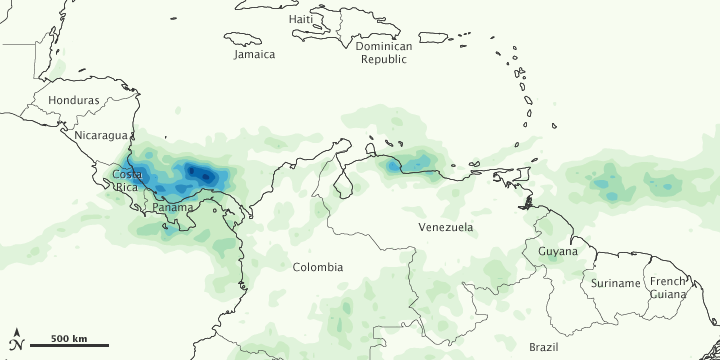


Relentless rain wreaked havoc in Venezuela, Colombia, and Costa Rica in late November and early December 2010. Some 2,000 residents were forced to evacuate their homes in Costa Rica, more than 20 people perished from flooding in Venezuela, and more than 170 people were killed in Colombia, according to news reports.
This color-coded map shows rainfall amounts from November 25 to December 1, 2010. The heaviest rainfall—more than 400 millimeters (almost 16 inches)—appears in dark blue. The lightest rainfall—less than 50 millimeters (almost 2 inches)—appears in light green.
A band of heavy rainfall runs east-west, skirting the coast of Venezuela, and extending across the Central American Isthmus. The rain is heaviest just off the coast of Panama. Over land, rain is heaviest over Costa Rica. A pocket of heavy rain also occurs along the Venezuelan coast. Venezuelan communities are especially vulnerable to heavy rain where millions of poor residents live in hillside shantytowns along the Caribbean coast, reported Reuters.
This image also shows relatively heavy rain in southern Venezuela and Colombia, continuing a weeks-long pattern. The Associated Press and MSNBC reported that floods striking Colombia had killed 174 people, destroyed 1,800 homes, damaged some 256,000 homes, and impacted more than 1.5 million people by December 4, 2010.
Weather Underground reported that Colombia’s rainy season usually winds down by December. The rainy season remained strong in December 2010, however, thanks to the Intertropical Convergence Zone where winds from the Northern and Southern Hemispheres meet and fuel strong storms. La Niña conditions enhanced the rainfall by collecting a large area of relatively cool ocean water off Colombia’s Pacific coast.
This image is based on data from the Multisatellite Precipitation Analysis produced at NASA’s Goddard Space Flight Center, which estimates rainfall by combining measurements from many satellites and calibrating them using rainfall measurements from the Tropical Rainfall Measuring Mission (TRMM) satellite.
NASA Earth Observatory image by Jesse Allen, using near-real-time data provided courtesy of TRMM Science Data and Information System at Goddard Space Flight Center. Caption by Michon Scott.